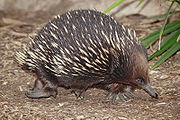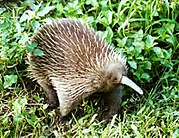Monotreme
From Wikipedia, the free encyclopedia
| Monotremes[1] Fossil range: 123–0 Ma Early Cretaceous - Recent |
||||||||
|---|---|---|---|---|---|---|---|---|
 |
||||||||
| Scientific classification | ||||||||
|
||||||||
| Families | ||||||||
|
†Kollikodontidae |
Monotremes (from the Greek Word, monos 'single' + trema 'hole', referring to the cloaca) are mammals that lay eggs (Prototheria) instead of giving birth to live young like marsupials (Metatheria) and placental mammals (Eutheria).
They are conventionally treated as comprising a single order Monotremata, though a recent classification proposes to divide them into the orders Platypoda (the Platypus along with its fossil relatives) and Tachyglossa (the echidnas). The entire grouping is also traditionally placed into a subclass Prototheria, which was extended to include several fossil orders but these are no longer seen as constituting a natural group allied to monotreme ancestry. A controversial hypothesis now relates the monotremes to a different assemblage of fossil mammals in a clade termed Australosphenida.
Contents |
[edit] General characteristics
Like other mammals, monotremes are warm-blooded with a high metabolic rate (though not as high as other mammals, see below); have hair on their bodies; produce milk through mammary glands to feed their young; have a single bone in their lower jaw; and have three middle ear bones.
Monotremes were very poorly understood for many years, and to this day some of the 19th century myths that grew up around them endure. It is still sometimes thought, for example, that the monotremes are "inferior" or quasi-reptilian, and that they are a distant ancestor of the "superior" placental mammals. It now seems clear that modern monotremes are the survivors of an early branching of the mammal tree; a later branching is thought to have led to the marsupial and placental groups.
A feature of monotremes (and also marsupials) is the claim they don't have a gross communication (corpus callosum) between the right and left brain hemisphere.[citation needed]

The key anatomical difference between monotremes and other mammals is the one that gave them their name; Monotreme means 'single opening' in Greek, and comes from the fact that their urinary, defecatory, and reproductive systems all open into a single duct, the cloaca. This structure is very similar to the one found in reptiles. Monotremes and marsupials have a single cloaca (though marsupials also have a separate genital tract) while placental mammal females have separate openings for reproduction, urination and defecation: the vagina, the urethra, and the anus.
Monotremes lay eggs. However, the egg is retained for some time within the mother, who actively provides the egg with nutrients. Monotremes also lactate, but have no defined nipples, excreting the milk from their mammary glands via openings in their skin. All species are long-lived, with low rates of reproduction and relatively prolonged parental care of infants. Infant echidnas are sometimes known as puggles referencing their similarity in appearance to the Australian children's toy designed by Tony Barber"Questions about The Lost Forests". http://australianet.com/tlf/faq.shtml. Retrieved on 2009-03-22. the same term, though not generally accepted, is popularly applied to young platypus as well.[2][3]
Extant monotremes lack teeth as adults. Fossil forms and modern platypus young have the "tribosphenic" molars (with the occlusal surface formed by three cusps arranged in a triangle), which are one of the hallmarks of extant mammals. Some recent work suggests that monotremes acquired this form of molar independently of placental mammals and marsupials,[4] although this is not well established.[5] The jaw of monotremes is constructed somewhat differently from those of other mammals, and the jaw opening muscle is different. As in all true mammals, the tiny bones that conduct sound to the inner ear are fully incorporated into the skull, rather than lying in the jaw as in cynodonts and other pre-mammalian synapsids; this feature, too, is now claimed to have evolved independently in monotremes and therians,[6] although, as with the analogous evolution of the tribosphenic molar, this is disputed.[7][8] The external opening of the ear still lies at the base of the jaw. The imminent sequencing of the platypus genome should shed light on this and many other questions regarding the evolutionary history of the monotremes.[9]
The monotremes also have extra bones in the shoulder girdle, including an interclavicle and coracoid, which are not found in other mammals. Monotremes retain a reptile-like gait, with legs that are on the sides of rather than underneath the body. The monotreme leg bears a spur in the ankle region; the spur is non-functional in echidnas, but contains a powerful venom in the male platypus.
[edit] Physiology
It is still sometimes said that monotremes have less developed internal temperature control mechanisms than other mammals, but recent research shows that monotremes maintain a constant body temperature in a wide variety of circumstances without difficulty (for example, the Platypus while living in an icy mountain stream). Early researchers were misled by two factors: monotremes maintain a lower average temperature than most mammals (around 32°C [90°F], compared to about 35°C [95°F] for marsupials, and 37°C [99°F] for most placentals); secondly, the Short-beaked Echidna (which is much easier to study than the reclusive Platypus) only maintains normal temperature when it is active: during cold weather, it conserves energy by "switching off" its temperature regulation. Finally, poor thermal regulation has also been observed in the hyraxes, which are placental mammals.
Their metabolic rate is remarkably low by mammalian standards. The Platypus has an average body temperature of about 32 °C (90 °F) rather than the 37 °C (99 °F) typical of placental mammals.[10] Research suggests this has been a gradual adaptation to harsh environmental conditions on the part of the small number of surviving monotreme species rather than a historical characteristic of monotremes.[11][12]
The monotremes are the only mammals that do not experience REM sleep.[13]
[edit] Taxonomy
The only surviving examples of monotremes are all indigenous to Australia and New Guinea, although there is evidence that they were once more widespread. Fossil and genetic evidence shows that the monotreme line diverged from other mammalian lines about 150 million years ago and that both the short-beaked and long-beaked echidna species are derived from a platypus-like ancestor. Fossils of a jaw fragment 110 million years old were found at Lightning Ridge, New South Wales. These fragments, from species Steropodon galmani, are the oldest known fossils of monotremes. Fossils from the genera Kollikodon, Teinolophos, and Obdurodon have also been discovered. In 1991, a fossil tooth of a 61-million-year-old platypus was found in southern Argentina (since named Monotrematum, though it is now considered to be an Obdurodon species). (See fossil monotremes below.)
- ORDER MONOTREMATA
- Family Ornithorhynchidae: platypus
- Genus Ornithorhynchus
- Platypus, Ornithorhynchus anatinus
- Genus Ornithorhynchus
- Family Tachyglossidae: echidnas
- Genus Tachyglossus
- Short-beaked Echidna, Tachyglossus aculeatus
- Tachyglossus aculeatus aculeatus
- Tachyglossus aculeatus acanthion
- Tachyglossus aculeatus lawesii
- Tachyglossus aculeatus multiaculeatus
- Tachyglossus aculeatus setosus
- Short-beaked Echidna, Tachyglossus aculeatus
- Genus Zaglossus
- Sir David's Long-beaked Echidna, Zaglossus attenboroughi
- Eastern Long-beaked Echidna, Zaglossus bartoni
- Zaglossus bartoni bartoni
- Zaglossus bartoni clunius
- Zaglossus bartoni diamondi
- Zaglossus bartoni smeenki
- Western Long-beaked Echidna, Zaglossus brujinii
- Genus Tachyglossus
- Family Ornithorhynchidae: platypus
[edit] Fossil monotremes
Excepting Ornithorhynchus anatinus, all the animals listed in this section are only known from fossils.
- Family Kollikodontidae
- Genus Kollikodon
- Species Kollikodon ritchiei. Ancient monotreme, 100-105 million years old.
- Genus Kollikodon
- Family Ornithorhynchidae
- Genus Ornithorhynchus. Oldest Ornithorhynchus specimen 9 million years old.
- Species Ornithorhynchus anatinus (Platypus). Oldest specimen 10,000 years old.
- Genus Obdurodon. Includes a number of Miocene (5-24 million years ago) Platypuses.
- Species Obdurodon dicksoni (Riversleigh Platypus)
- Species Obdurodon insignis
- Species Monotrematum sudamericanum. 61 million years old. (Originally placed in separate genus, now thought an Obdurodon)
- Genus Ornithorhynchus. Oldest Ornithorhynchus specimen 9 million years old.
- Family Tachyglossidae
- Genus Zaglossus. Upper Pleistocene (.1-1.8 million years ago).
- Species Zaglossus hacketti
- Species Zaglossus robustus
- Genus Megalibgwilia
- Megalibgwiilia ramsayi Late Pleistocene
- Megalibgwiilia robusta Miocene
- Genus Zaglossus. Upper Pleistocene (.1-1.8 million years ago).
- Family Steropodontidae. May be part of Ornithorhynchidae; closely related to modern platypus.
- Genus Steropodon
- Species Steropodon galmani.
- Genus Teinolophos
- Species Teinolophos trusleri. 123 million years old — oldest monotreme specimen.
- Genus Steropodon
[edit] Media
[edit] References
- ^ Groves, C. (2005-11-16). Wilson, D. E., and Reeder, D. M. (eds). ed. Mammal Species of the World (3rd edition ed.). Johns Hopkins University Press. pp. p. 1-2. ISBN 0-801-88221-4. http://www.bucknell.edu/msw3/browse.asp?id=10300001.
- ^ "An Echidna Puggle". Fourth Crossing Wildlife. http://www.fourthcrossingwildlife.com/echidna_puggle.htm. Retrieved on 2007-10-21.
- ^ "Platypus Fact File: Background and Naming". Australian Platypus Conservancy. http://www.platypus.asn.au/historical_background.html. Retrieved on 2008-03-26.
- ^ Luo, Z-X; Cifelli, R. L.; & Kielan-Jaworowska, Z. (2001). Dual origin of tribosphenic mammals.. 409. Nature. pp. 53–57.
- ^ Weil, A. 2001. Mammalian evolution: Relationships to chew over. Nature 409, 28-31 | doi:10.1038/35051199
- ^ Rich, T. H.; Hopson, J. A.; Musser, A. M.; Flannery, T. F.; & Vickers-Rich, P. (2005). "Independent origins of middle ear bones in monotremes and therians.". Science (Science) 307 (5711): 910–914. doi:. 10.1126/science.1105717. http://www.ncbi.nlm.nih.gov/entrez/query.fcgi?cmd=Retrieve&db=PubMed&list_uids=15705848&dopt=AbstractPlus.
- ^ "Comment on "Independent Origins of Middle Ear Bones in Monotremes and Therians" (I)". Science Magazine. http://www.sciencemag.org/cgi/content/full/sci;309/5740/1492a. Retrieved on 2007-10-21.
- ^ "Comment on "Independent Origins of Middle Ear Bones in Monotremes and Therians" (II)". Science Magazine. http://www.sciencemag.org/cgi/content/full/sci;309/5740/1492b. Retrieved on 2007-10-21.
- ^ "Platypus (Ornithorhynchus anatinus)". Ensembl. http://www.ensembl.org/Ornithorhynchus_anatinus/index.html. Retrieved on 2007-10-21.
- ^ "Thermal Biology of the Platypus". Davidson College. 1999. http://www.bio.davidson.edu/courses/anphys/1999/White/thermal.htm. Retrieved on 2006-09-14.
- ^ J.M. Watson and J.A.M. Graves (1988). "Monotreme Cell-Cycles and the Evolution of Homeothermy". Australian Journal of Zoology (CSIRO) 36 (5): 573–584. doi:.
- ^ T.J. Dawson, T.R. Grant and D. Fanning (1979). "Standard Metabolism of Monotremes and the Evolution of Homeothermy". Australian Journal of Zoology (CSIRO) 27 (4): 511–515. doi:.
- ^ Wolfe, Jeremy, Introduction to Psychology, Fall 2004. (Massachusetts Institute of Technology: MIT OpenCourseWare), http://ocw.mit.edu (Accessed December 10, 2008). License: Creative Commons BY-NC-SA
[edit] External links
| Wikimedia Commons has media related to: Monotremata |
| Wikispecies has information related to: Monotremata |
| The Wikibook Dichotomous Key has a page on the topic of |
| Look up monotreme in Wiktionary, the free dictionary. |
|
||||||||||||||
|
|||||||||||||||||||||



